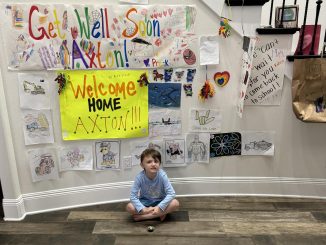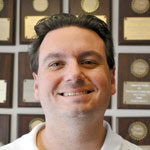
Program allowed him chance to see “a day in the life” of an Air Force pilot
Dakota Fabre doesn’t hesitate to tell what he looks forward to the most when he achieves his dream of becoming a fighter pilot in the Air Force.
“Just being in the sky, above the clouds,” Fabre mused. “It’s just the thrill of that … it’s amazing. And you get paid for it! It’s not a bad deal.”
Fabre, who is heading into his junior year at Destrehan High School, recently had the opportunity to get a taste of that future when he participated in a program offered by the Louisiana Air National Guard’s 122nd Fighter Squadron aimed at mentoring potential future pilots. The program gives participants a look behind the scenes, and that’s what Fabre had May 19 at the Naval Air Station Joint Reserve Base in New Orleans.

While there, Fabre got to fly a simulator, attended an actual pre-flight pilot briefing on how to strafe ground targets and perform strafing maneuvers in an F-15 fighter aircraft and sit in the seat of an F-15 Eagle Fighter Jet.
He was also able to see some of the flight equipment worn by pilots, including harness, anti-gravity suit and high tech helmet, and try on some of the gear himself. Fabre got to watch several F-15s take off from the flight line for training missions and toured the different parts of one himself.
“I really liked all of it,” Fabre said. “Being in the briefing room, seeing the jet take off was exciting … flying the simulator was amazing.”
Fabre said the simulator felt in many ways like he was operating a real jet.
“It had almost all the aspects,” he said. [pullquote]“Just being in the sky, above the clouds. It’s just the thrill of that … it’s amazing.” – Dakota Fabre[/pullquote]
The briefing, he said, was made unclassified for the group of attendees, who learned about what situations and scenarios the pilots would be simulating on the day.
“It’s what they’re simulating, what kind of attacks they had to do, and they were very specific in everything you have to do,” Fabre said. “It was really like experiencing a day in the life of a pilot.”
Fabre became interested in the Air Force through his brother, who like Fabre was in the junior ROTC program at DHS and is now learning about aviation on the collegiate level.
 “I thought it would be cool if we were both pilots in the Air Force,” Fabre said. “I’d hear all kinds of stories and it just got me interested.”
“I thought it would be cool if we were both pilots in the Air Force,” Fabre said. “I’d hear all kinds of stories and it just got me interested.”
He learned about the recruiting program through ROTC and applied to be a part of it online. He requested the chance to perform a job shadow with one of the officers and it was granted.
Fabre has also initiated the creation of the Air Force Association sponsored CyberPatriot team at DHS. It’s a cyber defense team competition in which students are put in the position of newly hired professionals tasked with managing the network of a small company. In the rounds of competition, teams are given a set of virtual images that represent operating systems and are tasked with finding cybersecurity vulnerabilities within the images and hardening the system.
“It’s a lot of fun, all about helping out and looking after people,” Fabre said.





Be the first to comment